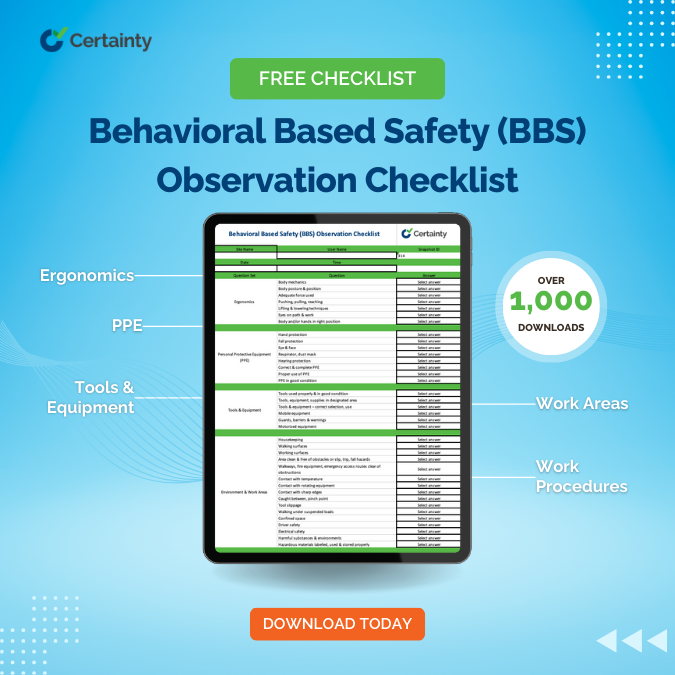Free Behavioral Based Safety (BBS) Observation Checklist Template
Identify and prevent unsafe behaviors before the incidents occur.

Certainty Software’s free Behavior-Based Safety (BBS) Observation Checklist is a powerful tool designed to help organizations identify, document, and address unsafe behaviors before they result in workplace incidents.
Downloaded by over 1,000 safety management leaders, it has become a pillar of comprehensive safety programs globally. This checklist supports your behavior-based safety efforts through guiding consistent observations, identifying at-risk behaviors, and enabling meaningful corrective actions.
What is Behavioral Based Safety (BBS)?
Behavior-Based Safety (BBS) is a proactive approach to workplace safety that focuses on observing and influencing employee behaviors. It is grounded in behavioral science, using consistent observations and positive feedback to promote safe practices and reduce unsafe acts. BBS emphasizes that most workplace incidents are rooted in unsafe behaviors rather than unsafe conditions alone.
A well-implemented BBS program empowers employees to take ownership of their actions, encourages peer-to-peer observations, and helps develop a culture of continuous improvement. The process uses structured observation forms to track behaviors, identify root causes, and drive safety.
Behavioral Based Safety follows 4 major principles:
- Antecedent-Behavior-Consequence (ABC) Model: Understand what prompts behavior and its outcomes.
- Positive Reinforcement: Encourage safe behaviors through acknowledgment and rewards.
- Employee Involvement: Engage frontline staff in peer observations and feedback loops.
- Data-Driven Decisions: Track and trend behaviors over time to pinpoint risks before they escalate.
Why Behavioral Observations Matter in Workplace Safety
According to EU-OSHA, 80-90% of workplace incidents can be traced back to human behavior. When organizations focus on employee behaviors, rather than primarily on environmental hazards, companies are more capable can:
- Prevent injuries and near misses before they happen
- Identify patterns of at-risk-behaviors across teams or job roles
- Improve the overall safety performance and compliance of your organization
- Foster a stronger safety culture based on shared responsibility
What Certainty’s BBS Observation Checklist Template Includes

Our 56-question Behavior-Based Safety Observation Checklist covers both reinforcing positive behaviors while addressing and mitigating at-risk behaviors across multiple key categories:
Who Should Use This BBS Observation Checklist?
Valuable for anyone involved in workplace safety, this free checklist template supports any level of safety management within an enterprise, including:

EHS Professionals & Safety Managers

Frontline Supervisors & Team Leads

Health & Safety Committees

Safety Consultants & Auditors

HR & Compliance Officers
Regardless of being used in conducting routine safety audits or integrating BBS into your management system, this BBS observation checklist enhances your observation process and contributes to continuous improvement.
How to Effectively Use the Behavioral Based Safety Observation Checklist
For you and your team to generate the most value out of the free BBS Observation Checklist, it’s recommended to follow these best practices followed by others that have downloaded this checklist:
- Train Your Observers: Ensure that those performing observations understand the intent, process, and what constitutes a safe or unsafe act. Observers should be trained using industry-recognized programs like the National Association of Safety Professionals’ Behavior-Based Safety course, which covers essential observation skills, reinforcement strategies, and the core components of BBS principles tailored to U.S. workplace safety standards.
- Be Consistent: Conduct regular observations across shifts and job roles to get an accurate picture of safety performance. Ideally, observations should occur daily or weekly, depending on the level of risk, workforce size, and organizational goals.
- Track Your Data: Track observation results and trends over time. Are certain unsafe behaviors recurring, like employees bypassing PPE protocols or failing to follow lockout/tagout procedures? Which safe behaviors are improving, such as consistent use of fall protection equipment or adherence to lifting techniques? These insights should inform corrective actions, refresher training, or policy updates.
- Follow-Up on At-Risk Behaviors: Address root causes, document corrective actions, and verify follow-through. Timely intervention not only prevents future incidents but also demonstrates organizational accountability.
- Close the Loop: Share insights and lessons learned with your workforce to strengthen safety training and build engagement. Communication helps create transparency, fosters collaboration, and turns observations into organizational learning opportunities.
The Expected ROI of a Behavior-Based Safety Checklist
Try our Certainty ROI Calculator
Enterprises have seen strong tangible benefits after they have implemented a Behavior-Based Safety Program through assets such as Certainty’s BBS Observation Checklist. Such ROI includes:
- Fewer recordable incidents and injuries
- Reduced workers’ compensation costs
- Improved OSHA compliance
- Greater employee engagement in safety processes, meetings, and toolbox talks
- Stronger alignment with organizational health and safety goals
Insight: Companies implementing BBS programs often report reductions in incident rates of 25% to 29% within the first year alone. (source)
Why Safety Leaders Trust Certainty For BBS Observation Management
The Problem We Are Seeing
Many organizations struggle to scale their behavior-based safety programs due to paper-based observation forms, inconsistent data tracking, and a lack of visibility into corrective actions. These limitations can lead to missed follow-ups, inefficient audits, and an inability to spot high-risk trends across sites.
The Solution We’ve Built
Certainty Software transforms these challenges into strengths by digitizing and automating your BBS observation process. With Certainty, you can:
- Complete inspections via mobile or desktop, online or offline
- Customize observation forms to fit your site-specific needs
- Automatically assign and track corrective actions
- Filter and analyze data by site, behavior type, or observation outcome
- Generate real-time dashboards and reports for leadership
Certainty empowers safety leaders with the tools they need to make informed, proactive decisions that improve safety performance and reduce risk organization-wide.
Take the next step in your BBS Program and schedule a call with our team to see for yourself how much easier and more accurate your safety management can be with Certainty.

Spend Time On Prevention
Not Paperwork
Watch our overview video to see how your organization can benefit from Certainty.
Watch Video



